display FIAT TALENTO 2021 Owner handbook (in English)
[x] Cancel search | Manufacturer: FIAT, Model Year: 2021, Model line: TALENTO, Model: FIAT TALENTO 2021Pages: 236, PDF Size: 4.86 MB
Page 141 of 236
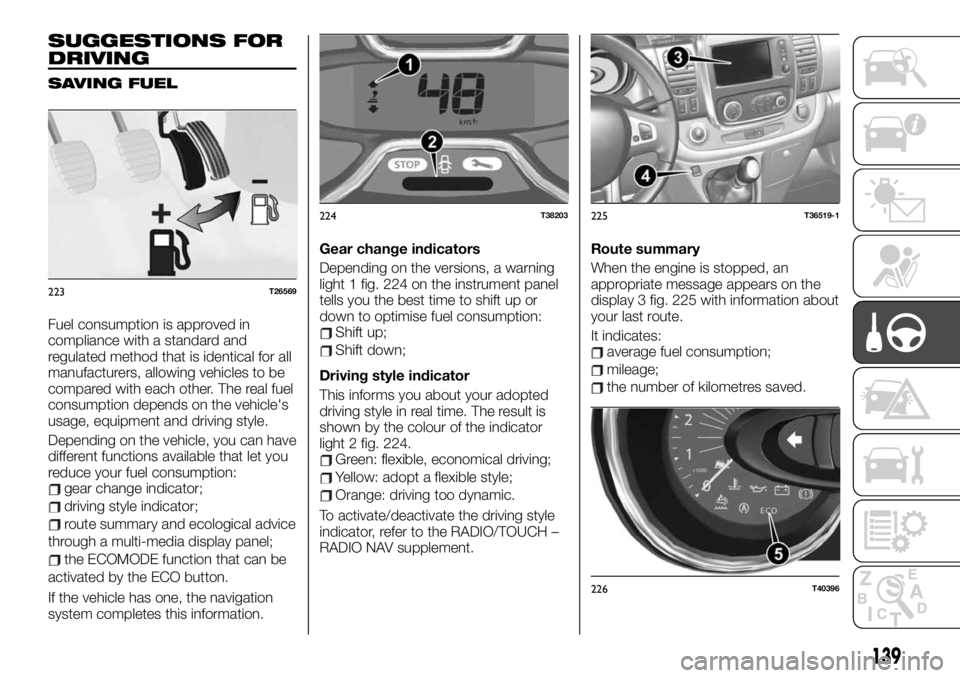
SUGGESTIONS FOR
DRIVING
SAVING FUEL
Fuel consumption is approved in
compliance with a standard and
regulated method that is identical for all
manufacturers, allowing vehicles to be
compared with each other. The real fuel
consumption depends on the vehicle's
usage, equipment and driving style.
Depending on the vehicle, you can have
different functions available that let you
reduce your fuel consumption:
gear change indicator;
driving style indicator;
route summary and ecological advice
through a multi-media display panel;
the ECOMODE function that can be
activated by the ECO button.
If the vehicle has one, the navigation
system completes this information.Gear change indicators
Depending on the versions, a warning
light 1 fig. 224 on the instrument panel
tells you the best time to shift up or
down to optimise fuel consumption:
Shift up;
Shift down;
Driving style indicator
This informs you about your adopted
driving style in real time. The result is
shown by the colour of the indicator
light 2 fig. 224.
Green: flexible, economical driving;
Yellow: adopt a flexible style;
Orange: driving too dynamic.
To activate/deactivate the driving style
indicator, refer to the RADIO/TOUCH –
RADIO NAV supplement.Route summary
When the engine is stopped, an
appropriate message appears on the
display 3 fig. 225 with information about
your last route.
It indicates:
average fuel consumption;
mileage;
the number of kilometres saved.
223T26569
224T38203225T36519-1
226T40396
139
Page 171 of 236
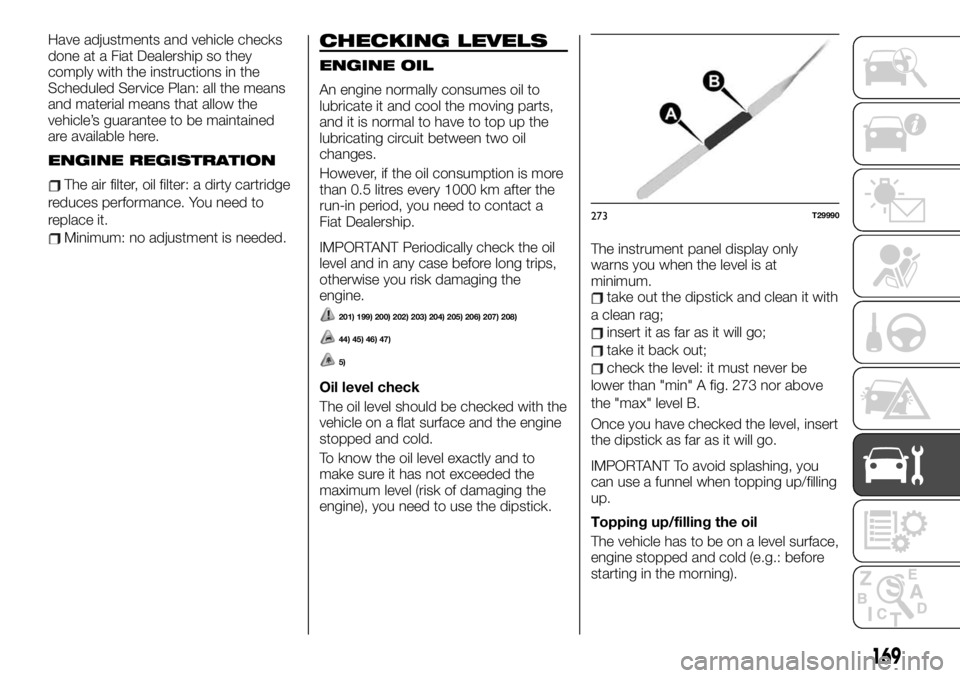
Have adjustments and vehicle checks
done at a Fiat Dealership so they
comply with the instructions in the
Scheduled Service Plan: all the means
and material means that allow the
vehicle’s guarantee to be maintained
are available here.
ENGINE REGISTRATION
The air filter, oil filter: a dirty cartridge
reduces performance. You need to
replace it.
Minimum: no adjustment is needed.
CHECKING LEVELS
ENGINE OIL
An engine normally consumes oil to
lubricate it and cool the moving parts,
and it is normal to have to top up the
lubricating circuit between two oil
changes.
However, if the oil consumption is more
than 0.5 litres every 1000 km after the
run-in period, you need to contact a
Fiat Dealership.
IMPORTANT Periodically check the oil
level and in any case before long trips,
otherwise you risk damaging the
engine.
201) 199) 200) 202) 203) 204) 205) 206) 207) 208)
44) 45) 46) 47)
5)
Oil level check
The oil level should be checked with the
vehicle on a flat surface and the engine
stopped and cold.
To know the oil level exactly and to
make sure it has not exceeded the
maximum level (risk of damaging the
engine), you need to use the dipstick.The instrument panel display only
warns you when the level is at
minimum.
take out the dipstick and clean it with
a clean rag;
insert it as far as it will go;
take it back out;
check the level: it must never be
lower than "min" A fig. 273 nor above
the "max" level B.
Once you have checked the level, insert
the dipstick as far as it will go.
IMPORTANT To avoid splashing, you
can use a funnel when topping up/filling
up.
Topping up/filling the oil
The vehicle has to be on a level surface,
engine stopped and cold (e.g.: before
starting in the morning).
273T29990
169
Page 181 of 236
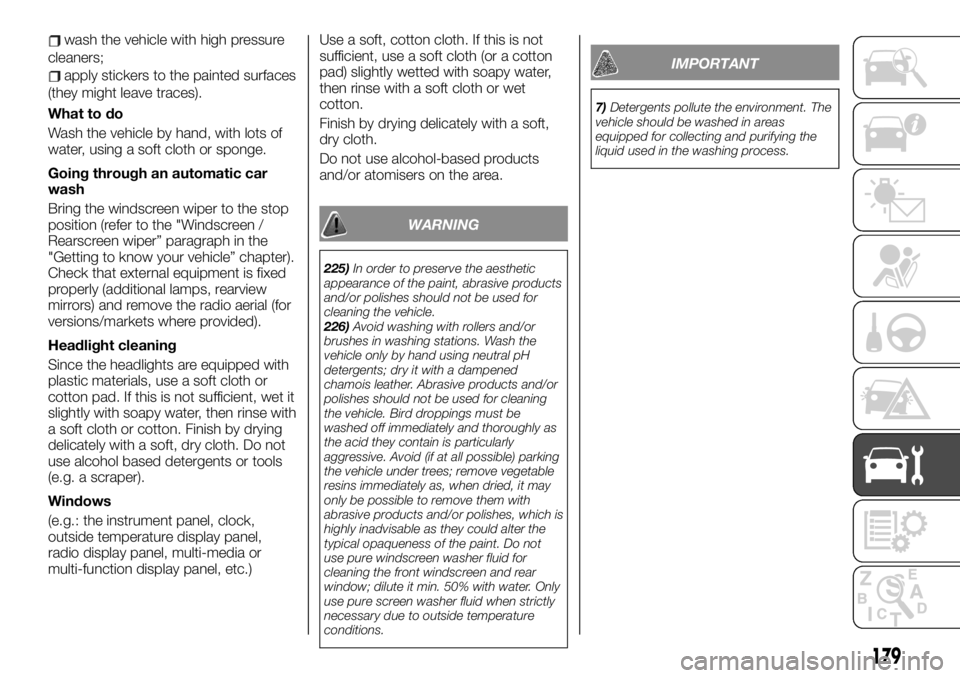
wash the vehicle with high pressure
cleaners;
apply stickers to the painted surfaces
(they might leave traces).
What to do
Wash the vehicle by hand, with lots of
water, using a soft cloth or sponge.
Going through an automatic car
wash
Bring the windscreen wiper to the stop
position (refer to the "Windscreen /
Rearscreen wiper” paragraph in the
"Getting to know your vehicle” chapter).
Check that external equipment is fixed
properly (additional lamps, rearview
mirrors) and remove the radio aerial (for
versions/markets where provided).
Headlight cleaning
Since the headlights are equipped with
plastic materials, use a soft cloth or
cotton pad. If this is not sufficient, wet it
slightly with soapy water, then rinse with
a soft cloth or cotton. Finish by drying
delicately with a soft, dry cloth. Do not
use alcohol based detergents or tools
(e.g. a scraper).
Windows
(e.g.: the instrument panel, clock,
outside temperature display panel,
radio display panel, multi-media or
multi-function display panel, etc.)Use a soft, cotton cloth. If this is not
sufficient, use a soft cloth (or a cotton
pad) slightly wetted with soapy water,
then rinse with a soft cloth or wet
cotton.
Finish by drying delicately with a soft,
dry cloth.
Do not use alcohol-based products
and/or atomisers on the area.
WARNING
225)In order to preserve the aesthetic
appearance of the paint, abrasive products
and/or polishes should not be used for
cleaning the vehicle.
226)Avoid washing with rollers and/or
brushes in washing stations. Wash the
vehicle only by hand using neutral pH
detergents; dry it with a dampened
chamois leather. Abrasive products and/or
polishes should not be used for cleaning
the vehicle. Bird droppings must be
washed off immediately and thoroughly as
the acid they contain is particularly
aggressive. Avoid (if at all possible) parking
the vehicle under trees; remove vegetable
resins immediately as, when dried, it may
only be possible to remove them with
abrasive products and/or polishes, which is
highly inadvisable as they could alter the
typical opaqueness of the paint. Do not
use pure windscreen washer fluid for
cleaning the front windscreen and rear
window; dilute it min. 50% with water. Only
use pure screen washer fluid when strictly
necessary due to outside temperature
conditions.
IMPORTANT
7)Detergents pollute the environment. The
vehicle should be washed in areas
equipped for collecting and purifying the
liquid used in the washing process.
179
Page 182 of 236
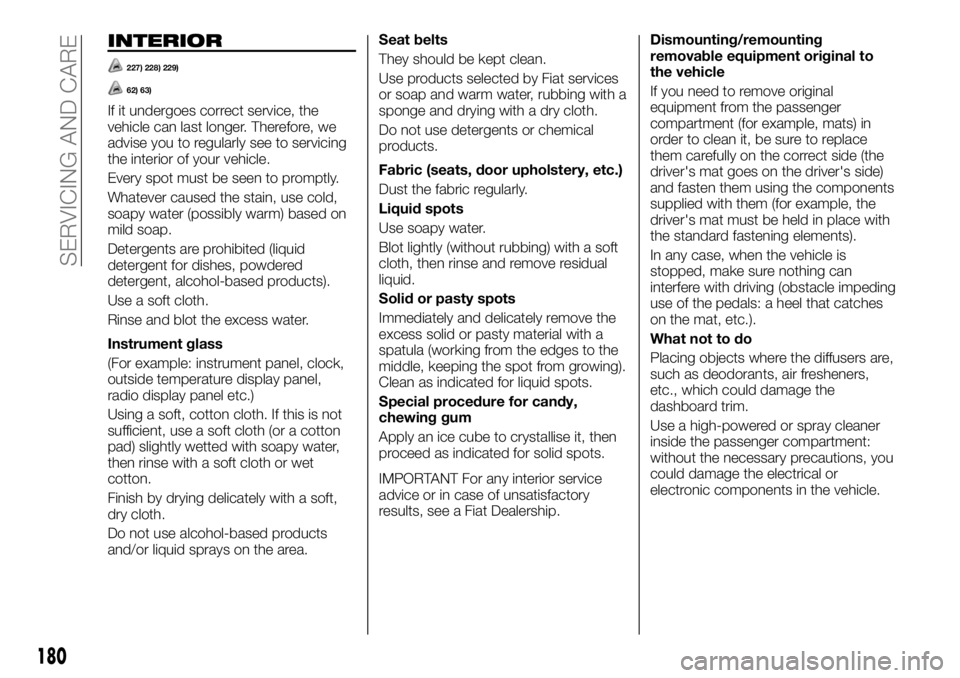
INTERIOR
227) 228) 229)
62) 63)
If it undergoes correct service, the
vehicle can last longer. Therefore, we
advise you to regularly see to servicing
the interior of your vehicle.
Every spot must be seen to promptly.
Whatever caused the stain, use cold,
soapy water (possibly warm) based on
mild soap.
Detergents are prohibited (liquid
detergent for dishes, powdered
detergent, alcohol-based products).
Use a soft cloth.
Rinse and blot the excess water.
Instrument glass
(For example: instrument panel, clock,
outside temperature display panel,
radio display panel etc.)
Using a soft, cotton cloth. If this is not
sufficient, use a soft cloth (or a cotton
pad) slightly wetted with soapy water,
then rinse with a soft cloth or wet
cotton.
Finish by drying delicately with a soft,
dry cloth.
Do not use alcohol-based products
and/or liquid sprays on the area.Seat belts
They should be kept clean.
Use products selected by Fiat services
or soap and warm water, rubbing with a
sponge and drying with a dry cloth.
Do not use detergents or chemical
products.
Fabric (seats, door upholstery, etc.)
Dust the fabric regularly.
Liquid spots
Use soapy water.
Blot lightly (without rubbing) with a soft
cloth, then rinse and remove residual
liquid.
Solid or pasty spots
Immediately and delicately remove the
excess solid or pasty material with a
spatula (working from the edges to the
middle, keeping the spot from growing).
Clean as indicated for liquid spots.
Special procedure for candy,
chewing gum
Apply an ice cube to crystallise it, then
proceed as indicated for solid spots.
IMPORTANT For any interior service
advice or in case of unsatisfactory
results, see a Fiat Dealership.Dismounting/remounting
removable equipment original to
the vehicle
If you need to remove original
equipment from the passenger
compartment (for example, mats) in
order to clean it, be sure to replace
them carefully on the correct side (the
driver's mat goes on the driver's side)
and fasten them using the components
supplied with them (for example, the
driver's mat must be held in place with
the standard fastening elements).
In any case, when the vehicle is
stopped, make sure nothing can
interfere with driving (obstacle impeding
use of the pedals: a heel that catches
on the mat, etc.).
What not to do
Placing objects where the diffusers are,
such as deodorants, air fresheners,
etc., which could damage the
dashboard trim.
Use a high-powered or spray cleaner
inside the passenger compartment:
without the necessary precautions, you
could damage the electrical or
electronic components in the vehicle.
180
SERVICING AND CARE
Page 233 of 236
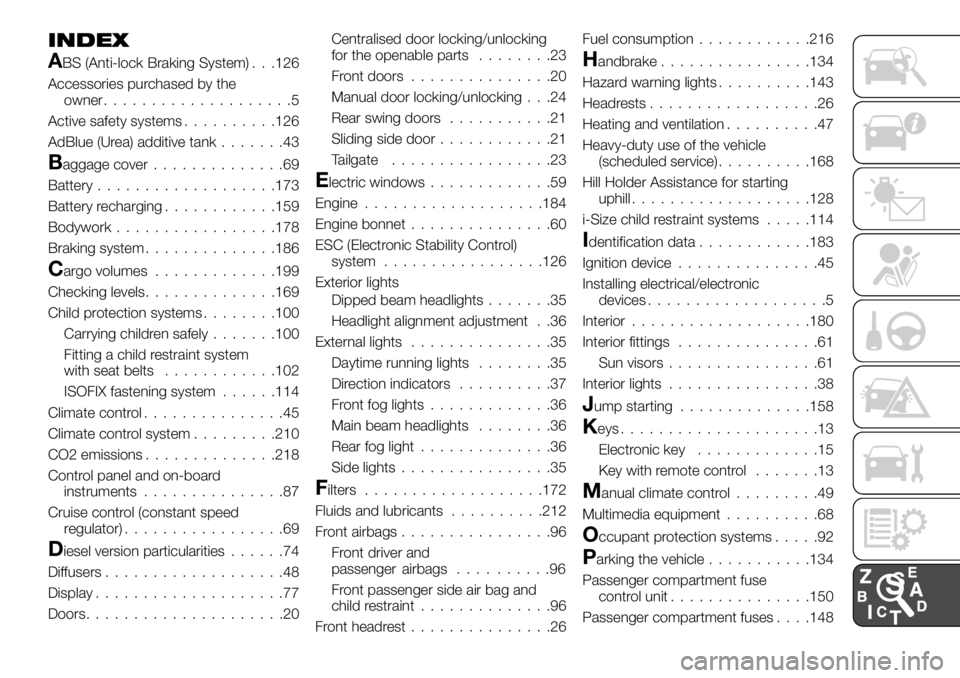
INDEX
ABS (Anti-lock Braking System) . . .126
Accessories purchased by the
owner....................5
Active safety systems..........126
AdBlue (Urea) additive tank.......43
Baggage cover..............69
Battery...................173
Battery recharging............159
Bodywork.................178
Braking system..............186
Cargo volumes.............199
Checking levels..............169
Child protection systems........100
Carrying children safely.......100
Fitting a child restraint system
with seat belts............102
ISOFIX fastening system......114
Climate control...............45
Climate control system.........210
CO2 emissions..............218
Control panel and on-board
instruments...............87
Cruise control (constant speed
regulator).................69
Diesel version particularities......74
Diffusers...................48
Display....................77
Doors.....................20Centralised door locking/unlocking
for the openable parts........23
Front doors...............20
Manual door locking/unlocking . . .24
Rear swing doors...........21
Sliding side door............21
Tailgate.................23
Electric windows.............59
Engine...................184
Engine bonnet...............60
ESC (Electronic Stability Control)
system.................126
Exterior lights
Dipped beam headlights.......35
Headlight alignment adjustment . .36
External lights...............35
Daytime running lights........35
Direction indicators..........37
Front fog lights.............36
Main beam headlights........36
Rear fog light..............36
Side lights................35
Filters...................172
Fluids and lubricants..........212
Front airbags................96
Front driver and
passenger airbags . . . . ......96
Front passenger side air bag and
child restraint..............96
Front headrest...............26Fuel consumption............216
Handbrake................134
Hazard warning lights..........143
Headrests..................26
Heating and ventilation..........47
Heavy-duty use of the vehicle
(scheduled service)..........168
Hill Holder Assistance for starting
uphill...................128
i-Size child restraint systems.....114
Identification data............183
Ignition device...............45
Installing electrical/electronic
devices...................5
Interior...................180
Interior fittings...............61
Sun visors................61
Interior lights................38
Jump starting..............158
Keys.....................13
Electronic key.............15
Key with remote control.......13
Manual climate control.........49
Multimedia equipment..........68
Occupant protection systems.....92
Parking the vehicle...........134
Passenger compartment fuse
control unit...............150
Passenger compartment fuses. . . .148